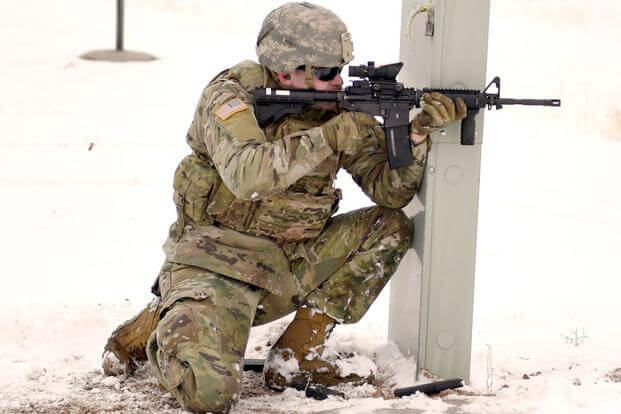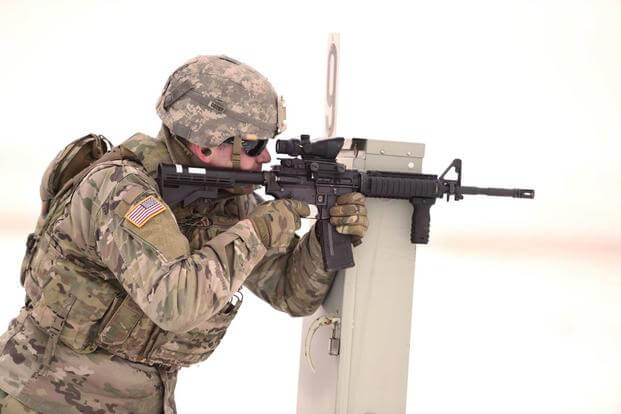The Army is about to release its new training strategy for a challenging marksmanship qualification standard that all soldiers will have to use to qualify annually with their M16 rifles and M4 carbines.
The new course will replace current, Cold War-era marksmanship qualification course with one that requires soldiers to engage targets faster and to operate as they would during an enemy engagement.
In the current qualification course, soldiers take many instructions from the range tower, such as when to change magazines and firing positions.
"What has changed specifically is, soldiers will change their magazines on their own ... in the past it was kind of an administrative thing," Sgt. 1st Class John Rowland, marksmanship program director at Benning's Infantry School, told Military.com.
"They change positions on their own. ... We incorporated the use of cover and or external support to drive home that tactical mindset of, don't be in the open when you have available cover around you, and incorporate things around you to stabilize your shot."
Related: Army to Kill Marksmanship Test Shortcut that Made Soldiers Less Deadly
The new, four-phase course also adds standing firing positions, Rowland said.
"Phase Number One is a react to contact, meaning they are going to start standing and the first engagement will present itself, and they will engage that from the standing unsupported position," Rowland said. "Then they will drop to the prone supported position."
Soldiers will then to go an unsupported prone position for Phase Two. Phase Three has soldiers engaging targets from the kneeling supported position.
Soldiers will then return to a supported standing position for phase four of the course, Rowland said.
"There will be sandbags out there like always ... and the common thing is going to be a barricade for the kneeling supported and the standing supported positions," Rowland said.
All of the information about the new course of fire will be in the new manual, TC 3-20.40 "Training and Qualification Individual Weapons." It's awaiting final approval at the Infantry Center, so it can be published and sent out to the active Army and National Guard and Reserve components, Rowland said.
Training officials at Benning said that there is no deadline for the Army to begin using the new marksmanship qualification standard. Unit commanders will have a year to provide Benning with feedback on any challenges they have with putting the new standard into operation on their home-station ranges.
The new course of fire will force soldiers to engage multiple targets at a time compared to the current qualification course that has a lot of single-engagement target exposures, Rowland said.
"The updated qualification has quite a few triple-engagement exposures, some quadruple-engagement exposures and a lot of doubles," he said. "This is to reinforce situational awareness, critical thinking and problem solving.
"It also saves time; the old qualification took about 20 minutes; this one takes like four minutes to execute."
As with the current system, the minimum score to pass in the new qualification is 23 hits out of 40. Soldiers must hit 23 to 29 targets for a Marksman rating, 30 to 35 for Sharpshooter and 36 to 40 for Expert, Rowland.
There are new requirements, however, for achieving Sharpshooter and Expert rating.
"In the past, soldiers did not have to engage, let alone hit, a 300-meter target to get an Expert rating," Rowland said. "Now there are five exposures of 300-meter targets, so in order for a soldier to get an Expert rating, they must hit at least one 300-meter target. ... To get Sharpshooter, a soldier must hit at least one target that's 250 meters or beyond."
Army training officials have spent the last two years refining the new course of fire, visiting units around the service to have soldiers run through it.
Soldiers from the Wyoming Army National Guard's Charlie Company, 1st Battalion, 297th Infantry Regiment (Forward) were the first to try out the new test at Camp Guernsey Joint Training Center in early March, according to recent Army news release.
The unit qualified using the Army's current qualification standard and then got a chance to try out the new course of fire, without any train-up on the new standard.
Sgt. Sol Griffith, a fire team leader with the Afton-based infantry company, demonstrated the new test for the rest of the unit.
"Now you have three or four targets up at the same time, and you have to transition between them very thoughtfully," Griffith said in the release. "It's not like it was with someone yelling what target is coming up."
Griffin, who normally scores 40 out of 40 on the current standard, hit 22 out of 40 targets while demonstrating the new, course of fire, according to the release.
About half of the soldiers in the unit met the minimum standard of 23 out of 40 hits, and 32 was the highest score on the new course of fire.
Marksmanship officials said the new manual will provide units with what they need to be successful on the updated standard. The training strategy for the new qualification course is broken down into six tables in TC 3-20.40:
Table 1: Preliminary marksmanship instruction and evaluation
Table 2: Pre-live fire simulation training
Table 3: Drills such as magazine changes and going to the prone position
Table 4: Basic grouping and zeroing
Table 5: Practice qualification
Table 6: Qualification
"It's no different from what successful units have been doing for years," Rowland said. "It's just laid out in a manner that units don't have to think about what they need to do to be successful. It's right there in the book ... which is a huge improvement for the past, where standards and training resourcing and what not were largely disjointed or nonexistent."
The new publication also requires units to perform the first three training tables before they go the live-fire tables, according to Melody Venable, training and doctrine officer for the Infantry School.
"It creates the reps and sets that we need amongst the force when it comes to increasing lethality," she said. "The biggest challenge that we see is change; accepting change. We are doing something different in their minds."
-- Matthew Cox can be reached at matthew.cox@military.com.














